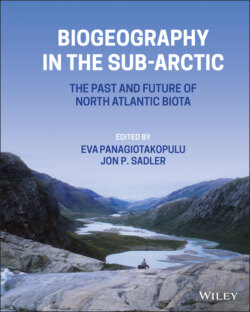Читать книгу Biogeography in the Sub-Arctic - Группа авторов - Страница 66
Late Glacial and Early to Mid‐Holocene Flora and Fauna
ОглавлениеLate glacial sediments from a locality in southernmost Greenland have been analysed for pollen (Björck et al. 2002). Not surprisingly, the concentration of pollen is extremely low and a large proportion of the pollen grains must be regarded as being long‐distance transported. Pollen of Poaceae, Sagina type, Saxifraga caespitosa type and Saxifraga stellaris type presumably come from the local vegetation, and the same apply to a few seeds of Minuartia sp. and Saxifraga cf. oppositifolia. The vegetation probably consisted of mosses and scattered pioneer herbs.
Deposits from the earlier Holocene from West and East Greenland also contain remains of bryophytes and herbs only, and the herbs represented are species that can tolerate low summer temperatures and unstable soils (Fredskild 1985; Bennike et al. 1999; Bennike 2000a; Wagner et al. 2010; Bennike and Wagner 2012; Wagner and Bennike 2012). The first woody plant that appears to have immigrated to Greenland is E. nigrum, which was present from ~11 000 years BP. It was soon followed by S. herbacea, known from 10 800 years BP, and V. uliginosum, known from 10 500 years BP. Betula nana arrived in Greenland at ~8800 years BP, S. glauca at ~8700 years BP and Juniperus communis at ~8400 years BP.
Chydorus arcticus is the most common and widespread cladoceran in Greenland, and the first species to immigrate after the last deglaciation, with the oldest remains dated to ~13 800 years BP. The species lived in South Greenland during the Younger Dryas. Daphnia arrived in South Greenland ~12 500 years ago. Acroperus harpae was also an early immigrant to South Greenland, but it disappeared during the Younger Dryas, and reappeared in the Early Holocene (Bennike and Björck 2000).
Among insects, head capsules of chironomid larvae are found in late glacial deposits (Bennike and Björck 2000) and remains of the caddis fly Apatania zonella are found in Early Holocene deposits (Bennike et al. 2000). Remains of the seed bug N. groenlandicus have been found in a fairly large number of deposits, and the species was an early immigrant to Greenland (Bennike et al. 2000; Böcher et al. 2012), although it has not been recorded from earliest Holocene deposits. Remains of water beetles are quite common in lake deposits and Colymbetes dolabratus remains have been recovered from Early Holocene deposits in both West and East Greenland. The ground beetle Bembidion grapii is widespread in southern Greenland and remains of it have been found in Early Holocene deposits in both East and West Greenland (Böcher and Bennike 1996; Böcher et al. 2012). The pill beetle S. metallica has also been found in Early Holocene deposits in West Greenland. A find dated to ~9920 years BP is the oldest record of a terrestrial beetle from Holocene Greenland (Böcher et al. 2012). From Mid‐Holocene deposits specimens of Rutidosoma globulus have recently been recorded; this is a species that is extremely rare in nowadays Greenland (Böcher et al. 2012). Finds in East Greenland of the leaf beetle Phratora cf. polaris in deposits dated to between 8700 and 7900 years BP are most surprising. This species, which is unknown in present day Greenland, is probably extinct (Böcher and Bennike 1996; Bennike et al. 1999). Mid‐Holocene insect faunas are well known from a few investigations of midden layers in central West Greenland, with remarkably well‐preserved remains (Figures 5e and 14; Böcher and Fredskild 1993).
Figure 14 Scanning electron microscope photographs of remains of insect remains from Mid‐Holocene midden deposits from Qeqertasussuk, West Greenland. (a, b) Elytra of Hydroporus morio and S. metallica. (c, d) Heads of Micralymna brevilingue and Nysius groenlandicus. Scale bars: 0.5 mm.
Source: From Böcher and Fredskild (1993).
Among vertebrates, the known temporal range of the small fish Gasterosteus aculeatus extends back to ~10 ka, that of reindeer R. tarandus to ~9 ka, that of wolf Canis lupus to ~8 ka and that of musk‐ox Ovibos moschatus to ~5 ka (Meldgaard 1986; Bennike 1997, 2013; Bennike and Björck 2002; Campos et al. 2010).
